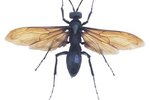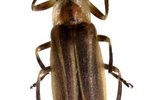
Moths are insects that are part of the order Lepidoptera, as are butterflies. Although the two types of insects have a lot in common, butterflies are generally a lot more vivid in coloration. Moths, like butterflies, are equipped with miniscule scaled wings, and the scientific name of their order translates to exactly that. The planet is home to more than 142,000 types of moths.
Wooing and Mating
Reproduction in the moth world starts with the wooing process. Female moths often initiate mating by emitting pheromones that are meant to lure in males. Once the males pick up on the scent of pheromones, they swiftly travel to find its origin. They usually don't dillydally once they get to the females -- they tend to mate straightaway. Certain male moths employ their wings to give off pheromones before mating, however. Once mating is complete, the females begin their hunt for suitable places to deposit their eggs. The main criteria is the presence of a plant that can provide sustenance to future larvae.
Depositing Eggs
Once mature female moths track down an ideal spot, they deposit their eggs. Some female moths deposit a few of them, while others deposit thousands and thousands -- the number varies according to species. Most moths deposit eggs numbering in the hundreds.
Coming Out as Caterpillars
"Moths" come out of the eggs as caterpillars. These larvae are elongated in appearance, similar to worms. They begin their lives consuming the plants that surround them, and because of that they are frequently considered to be nuisances by human beings. Caterpillars often can consume most segments of plants, including roots, seeds, flowers and foliage. They develop swiftly and then are ready to move on to the next stage in their lives.
Moth Life Cycle
Although these insects are born as caterpillars, they don't stay in that form for too long. They generally live as caterpillars for anywhere from several weeks to several months. Once they enter into the pupation phase, they cease eating and all activity in general. They pupate in a variety of different places, sometimes in the dirt, sometimes amid heaps of foliage and sometimes while staying tight against plants. During pupation, they finish their metamorphosis into adulthood, and exit as fully grown individuals, complete with wings.
References
- CSIRO Ecosystem Sciences: Lepidoptera - Moths and Butterflies
- NC State University General Entomology: Lepidoptera
- Royal Entomological Society: Butterflies and Moths (Lepidoptera)
- University of Michigan BioKIDS: Lepidoptera
- University of Michigan Animal Diversity Web: Lepidoptera
- University of California Museum of Paleontology: Lepidoptera
- Queensland Museum: Butterflies and Moths
- Animal Planet: Butterflies and Moths
- Desert Museum: Moths
Photo Credits
-
Stockbyte/Stockbyte/Getty Images



